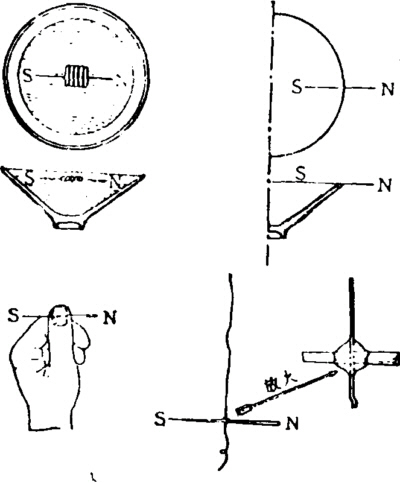Chapter 36 Section 2 Compass and Navigation
It is a great invention in ancient my country to use the polarity of magnets to manufacture guide instruments.In the classics of the pre-Qin period, there is a record that "the former king set up Sinan with Duan Chaoxi" ("Han Feizi Youdu Chapter"), and "Duan Chaoxi" means the square.In Wang Chong's "Lunheng · Shiying Pian", it is even recorded that "Sinan's ladle, thrown on the ground, is a guide." "Sinan's ladle" is carved into a ladle shape with natural magnets, and "ground" is a On the site marked with 24 directions, "Zi" is the handle of the ladle, that is, put the dipper-shaped magnet on the site, and its handle will point to the south.However, natural magnets are not easy to ponder, and will lose their magnetism, so they have not been popularized.
Around the end of Tang Dynasty or the beginning of Song Dynasty, people invented the method of artificial magnetization and made compass.The compass was originally invented by Mr. Feng Shui. They used an iron needle to rub against a magnet to make it magnetized to form a compass.According to Shen Kuo's "Mengxi Bi Tan", the original compass had four installation methods, that is, the water float method, the magnetic needle traverses the rush grass to make it float on the water; it is placed on the lip of the bowl; it is placed on the nail; Magnetic needle center, hang up.At that time, people had already discovered the magnetic declination of the earth.The later method of compass installation is generally to dig a round hole in the center of the site (also called compass or compass in ancient times), fill it with water, and put it into a magnetic needle that traverses the rushes to become a water compass.Before the end of Ming Dynasty, this kind of water compass was widely used.
The biggest achievement of the compass is that it has greatly promoted the development of navigation.Our ancestors have been active in the sea for a long time. The ruins of the mother's society found on Daheishan Island in Shandong Province reflect that the ancestors began to live on the island six to seven thousand years ago.During the reign of Qin Shihuang, Xu Fu took thousands of boys and girls to Japan to the east, creating a precedent for large-scale voyages.During the Han and Tang Dynasties, my country's merchant ships were already active in the Pacific Ocean and the Indian Ocean, and had frequent maritime traffic relations with many countries in Northeast Asia, Southeast Asia, South Asia, Southwest Asia, and even the east coast of Africa.Before the compass was used in navigation, sea voyages relied on observing the sun, moon, and stars to identify directions.If run into cloudy and rainy weather, water and sky are the same color in the vast sea, have to drift with the current, resign oneself to fate, the accident of getting lost often takes place.The appearance of the compass provided navigators with a reliable means of all-weather navigation.Our country began to apply the compass to navigation around the end of the 11th century.


Figure 12 Restoration map of Sinan

Figure 13 Schematic diagram of the initial compass device
The application of the compass in navigation has caused a major change in navigation technology and created a new era of human navigation.Dr. Needham said that this was a "great reformation in the art of navigation", which brought "the primitive age of navigation to the end" and "heralded the advent of the age of measurement navigation".The highly developed navigation industry in the Song and Yuan dynasties of our country, Zheng He's voyages to the Western Seas in the early Ming Dynasty, and the advent of the era of navigation by the European People's Congress are all closely related to the invention and application of the compass.
The Chinese compass was spread to Arabia by sea and then to Europe in the second half of the 12th century.At the same time, it may also spread to Central Asia by land, and then to Europe.Europeans improved the compass device during the application process and invented a dry compass with a fixed fulcrum, just like the one we commonly use now.The dry compass was brought back to China in the second half of the 16th century, thus gradually replacing the water compass.


Figure 12 Restoration map of Sinan

Figure 13 Schematic diagram of the initial compass device
